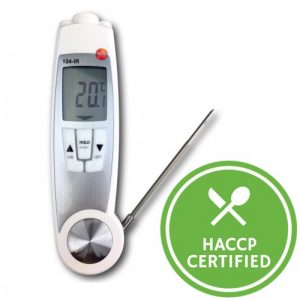An infrared thermometer measures temperature based on infrared radiation, which is the radiation given off by objects at a very high temperature. Infrared radiation has been the “red-hat” of science fiction for decades now, and yet it is one of the most important types of radiation to us humans. The average human spends roughly 2.5 hours per day absorbing infrared radiation from everything from stars in the universe to heat emitted from your own body. Infrared thermometers are used in many kinds of applications to measure temperature, including many medical treatments.
An infrared thermometer measures temperature based on infrared radiation, which is the radiation given off by an object at a high temperature. The infrared radiation has a slightly longer wavelength than visible light, meaning it has a shorter range than the sun’s rays, but a longer range than any other radiation we know. A good infrared thermometer will be sensitive to changes in this radiation’s wavelength as well as its intensity. The best way to specify how sensitive an instrument is to this is to look at its maximum temperature range – the highest measurement it can take (which will be negative in case of liquids) and compare that to its maximum spot ratio, which is the ratio of the maximum temperature to the lowest temperature that it can take.
Maximum temperature and minimum temperature readings are usually calibrated against specific times of day. While days of the week are generally easy to measure, it is the day of the week that is generally used for infrared thermometers. On a typical day, there is usually a large range in surface temperatures from early morning through late in the evening. For this reason, thermometers are usually calibrated against a standard 24 hour period.
 A common infrared thermometer measurement is taken when you are measuring temperatures at a particular station. Your machine will typically have a built-in distance-to-spot correlation. The larger the measurement area, the higher the correlation will be between temperature readings taken at different stations. However, this correlation can be affected by winds, clouds, and other factors, so it is not always reliable. You can also measure the average distance-to-spot temperature without a correlation by using an averaging procedure.
A common infrared thermometer measurement is taken when you are measuring temperatures at a particular station. Your machine will typically have a built-in distance-to-spot correlation. The larger the measurement area, the higher the correlation will be between temperature readings taken at different stations. However, this correlation can be affected by winds, clouds, and other factors, so it is not always reliable. You can also measure the average distance-to-spot temperature without a correlation by using an averaging procedure.
There are some infrared thermometers that don’t require any measuring vessels or containers. This is called a digital thermometer, which does not require temperature containers in order to record the results. The digital thermometers measure IR radiation. In order to provide accurate measurements, you should place the probe into an IR container. It should be placed into an area with no dust in order to maximize the accuracy of your measurement.
All infrared thermometers use an infrared emitter, which converts the IR radiation emitted by objects into heat. They measure the heat produced by the radiation emitted by these objects. Because this process is not possible for gases or liquids, the only way to measure heat is through a glass sphere or plate. These two items act as a barrier between the source of radiation emitted by an object and the infrared thermometer probe.
